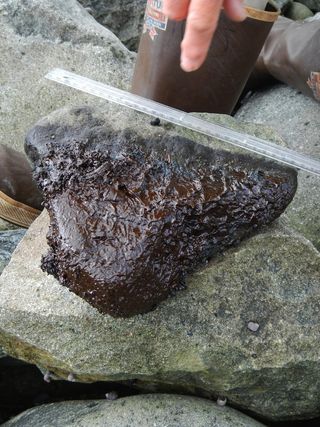Pockets of Oil from Exxon Valdez Spill Persist Along Alaskan Coast

Small pockets of oil from the 1989 Exxon Valdez oil spill still persist in pockets along Alaska's coasts, hidden by rocks that have kept the elements from breaking down the crude oil, scientists reported yesterday (Feb. 27).
The Exxon Valdez spill was the largest oil spill in U.S. history until 2010's Deepwater Horizon disaster, with nearly 11 million gallons (40 million liters) of oil pouring into Prince William Sound. (For comparison, the Deepwater Horizon spill spewed more than 200 million gallons, or 750 million liters, of oil into the Gulf of Mexico.)
During a study aimed at finding out how long oil persists after a spill, a group of scientists examined the Shelikof Strait coastline southwest of the spill site. They found pockets of oil hidden behind stable boulders that seem to protect the oil from the actions of waves and other forces that break the oil down over time, keeping it in a state similar to when it was first spilled.

"To have oil there after 23 years is remarkable," Gail Irvine of the U.S. Geological Survey's Alaska Science Center said in a statement. "We have these marked boulders whose movement we've been studying for more than 18 years. The oil itself has hardly weathered and is similar to 11-day-old oil."
Oil drilled from different locations has different chemical fingerprints, and chemists were able to test the unweathered oil and confirm that it came from the Exxon Valdez, which was carrying oil from Alaska's Prudhoe Bay. [SOS! Major Oil Disasters at Sea]
Christopher Reddy, whose lab at the Woods Hole Oceanographic Institution in Massachusetts did the "fingerprinting" of the oil, said that the study showed something of a silver lining in the Exxon Valdez spill, in that scientists are learning which compounds in oil are more or less susceptible to weathering and where oil tends to persist after a spill.
"One lesson is that if you are responsible for cleaning up a spill, you want to be proactive about cleanup behind the boulders," Reddy said in the statement.
Sign up for the Live Science daily newsletter now
Get the world’s most fascinating discoveries delivered straight to your inbox.
The researchers, who presented their work yesterday at the American Geophysical Union's annual Ocean Sciences Meeting in Honolulu, did note that the amount of oil they found is a small fraction of the total oil spilled and that the findings can't necessarily be extended to the whole of the spill area.
Follow Andrea Thompson @AndreaTOAP, Pinterest and Google+. Follow us @livescience, Facebook & Google+. Original article on Live Science.

Andrea Thompson is an associate editor at Scientific American, where she covers sustainability, energy and the environment. Prior to that, she was a senior writer covering climate science at Climate Central and a reporter and editor at Live Science, where she primarily covered Earth science and the environment. She holds a graduate degree in science health and environmental reporting from New York University, as well as a bachelor of science and and masters of science in atmospheric chemistry from the Georgia Institute of Technology.
